- HOME
- > Product
- > Measurement Instruments
- > Impedance Analyzer
- > Impedance Analyzer ZA57630 : Features
Impedance Analyzer
Impedance Analyzer
ZA57630Features
A diverse array of functions to suit any application!
Highly repeatable and accurate measurements.
Accurate assessments conducted under actual usage
conditions.
Electronic parts and materials may indicate varying
characteristics at different measurement frequencies or when different signal levels are
applied. To assess true characteristics, it is important to take measurements under
actual operating conditions by sweeping the frequency, AC amplitude and DC bias.
Features
- ● SWEEP
- ● SETTING MEASUREMENT AND OTHER CONDITIONS
- ● MEASUREMENT RANGE
- ● MEASUREMENT DELAY FUNCTION
- ● AUTOMATIC HIGH DENSITY SWEEP
- ● ERROR CORRECTION FUNCTION
- ● MARKER CONTROL
- ● SEQUENCE MEASUREMENT FUNCTION
- ● GRAPH DISPLAY
Useful Function
SWEEP Frequency, AC amplitude, DC bias, zero span
AC amplitude sweep
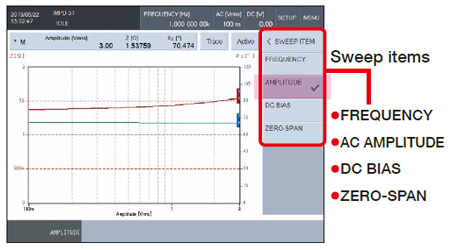
Frequency sweep
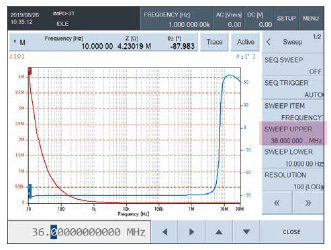
DC bias sweep
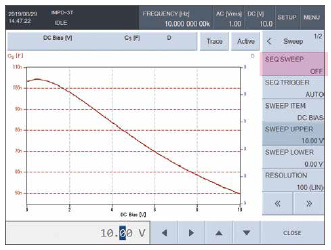
Zero span
Takes measurements under fixed conditions without changing frequency, AC amplitude or DC bias parameters, to observe the change in characteristics over time (horizontal axis: time)
● Also capable of spot measurements
Measures a fixed frequency, AC amplitude and DC bias, and displays the results as numerical values. Up to 6 items can be configured.
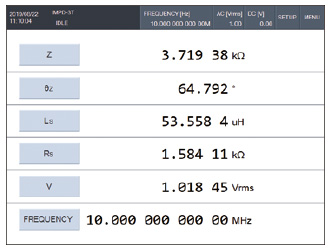
For measurements on production lines
SETTING MEASUREMENT AND OTHER CONDITIONS
Settings intuitively on a single screen
Setting items (SETTING VIEW)
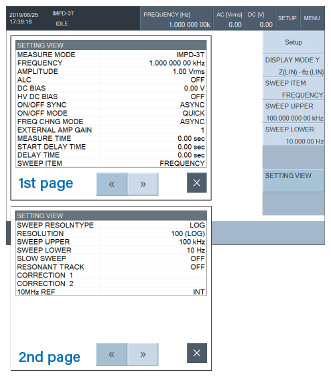
Graph axis setting
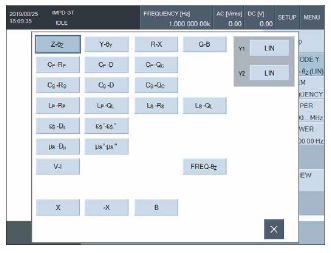
Frequency settings
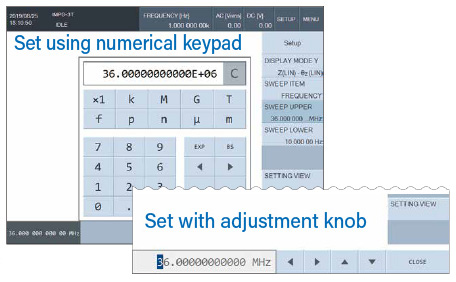
MEASUREMENT RANGE
Auto range
Takes measurements by setting the optimal measurement range automatically while monitoring measurement results. This is effective when there are significant changes in measurement data.
Fixed range
The measurement range is fixed, which prevents discontinuity (steps) in the measured value caused by changes in the range.
MEASUREMENT DELAY FUNCTION
If sweep parameters such as frequency or AC amplitude are changed while
sweep is in progress, incorrect measurement results can be generated due to transient
response.
The time until measurements start after parameters are changed can be delayed.
Two delay types are available: “Measurement start delay” and “Measurement
delay”
AUTOMATIC HIGH DENSITY SWEEP
This function automatically raises the frequency density only for sections
where the measurement data changes suddenly during frequency sweep measurements.
During resonance characteristic measurements of devices like piezoelectric vibrators and
crystal oscillators, this function is useful.
ERROR CORRECTION FUNCTION
Corrections to causes of measurement errors, for accurate assessments.
To conduct accurate measurements, various measurement error causes such as residual impedance and cable length must be corrected properly.
Open correction
Reduces errors caused by residual admittance
Short correction
Reduces errors caused by residual impedance
Load correction
Corrects deviations from true values using samples with known values as standard impedance
Port extension
Corrects phase errors due to transmission delay time when using long cables
Slope compensation
Removes the effect of potential fluctuation wave included in the measurement signal. Effective for measurements of samples such as batteries with potential changes due to charging and discharging
Equalizing
Measures the frequency characteristics of sensors, cables and other externally connected measurement devices, and corrects the amount of error of those measurement devices
Input weighting
Corrects the probe attenuation or pre-amp gain
Self-calibration
Self-calibrates errors
MARKER CONTROL
Reads the measurement values for X, Y1 and Y2 shown on the graph.
Up to 8 markers can be used.
Δ Marker
Displays the difference from the standard marker (Marker 1)
ΔTRKG Marker
Displays the difference in the same way as the difference marker. When marker 1 is moved, it moves while keeping the difference in the sweep value constant.
Marker search function
Automatically searches points that match the setting conditions
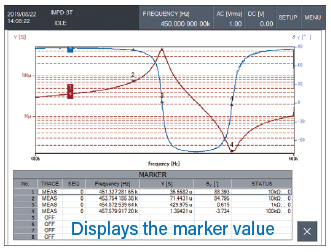
SEQUENCE MEASUREMENT FUNCTION
Multiple measurement conditions are set in advance, and this function
conducts measurements in order under those conditions.
The sweep range can be split into segments, with measurements taken under different
conditions for each segment range.
Enables efficient measurements of multilayer ceramic capacitors (MLCC), and other devices
with characteristics that vary with voltage.
GRAPH DISPLAY
SINGLE/SPLIT display
Select from “SINGLE” with one graph shown per screen, or “SPLIT” with two graphs shown top and bottom
Phase display control
±180°, 0° to +360°, −360° to 0°, UNWRAP (continuous display), 360° shift, aperture (group delay characteristics)
Trace control
Allows overwriting of measurement data trace (MEAS) and up to 8 reference data traces (REF)
Auto store
After sweep measurement is completed, this function automatically copies the MEAS trace to the REF trace.
● SPLIT display
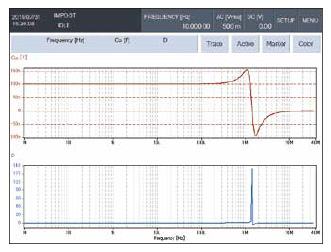
● Auto store
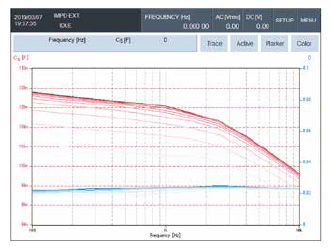
RESONANT FREQUENCY TRACKING FUNCTION
During measurement of samples with resonance, this function automatically tracks the measurement frequency with the sample resonant frequency. Measurement can always be conducted to match the resonant frequency. A convenient function for continuous measurements close to the resonant frequency of piezoelectric devices.
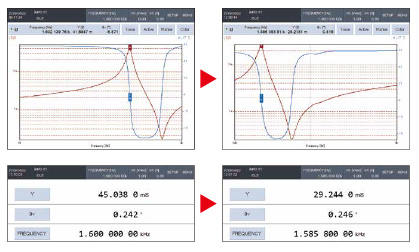
Resonant frequency changes (1.6 kHz to 1.5858 kHz),
tracks automatically
EQUIVALENT CIRCUIT ESTIMATION FUNCTION
A function that determines the LCR element value (values for impedance,
electrostatic capacitance and resistance) by applying the impedance characteristics acquired
with frequency sweep measurements to equivalent circuit models.
The following 6 models are included.
Equivalent circuit model
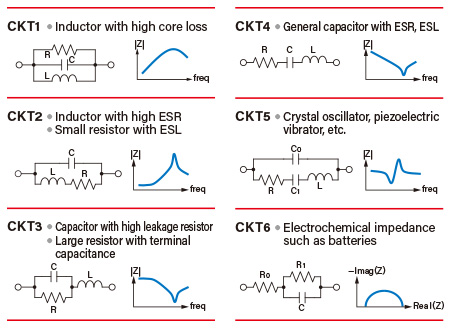
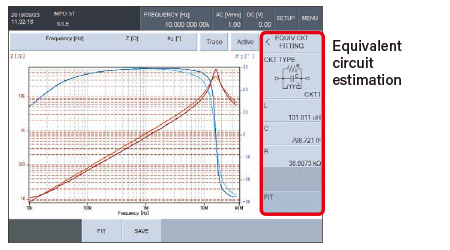
PIEZOELECTRIC CONSTANT CALCULATION FUNCTION
Function that measures frequency-impedance characteristics of piezoelectric ceramics to calculate the electromechanical coupling factor, piezoelectric constant and others.
∗JEITA standard-compliant method “EM-4501A Electrical test methods for piezoelectric ceramic vibrators”.
Measurement results
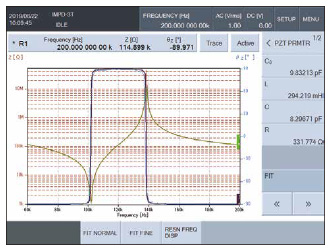
Constant calculation
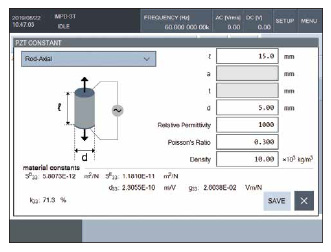
RELATIVE PERMITTIVITY MEASUREMENT
Sample dimensions and other information is set in advance, to calculate and display the complex relative permittivity from impedance measurement results (Cp, Rp).
● Relative permittivity εs
● Relative permittivity, real εs’
● Relative permittivity, imaginary εs”
● Loss ratio Dε
εs’−εs”
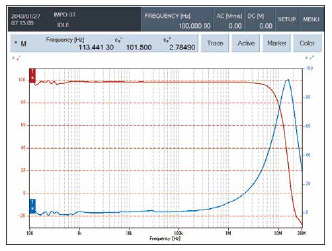
εs−Dε
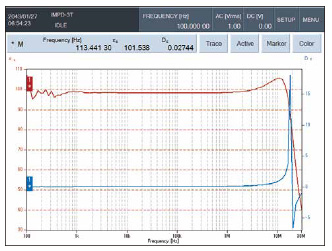
RELATIVE MAGNETIC PERMEABILITY MEASUREMENT
Sample dimensions and other information are set in advance, to calculate and display the complex relative magnetic permeability from impedance measurement results (Ls, Rs).
● Relative magnetic permeability µs
● Relative magnetic permeability, real µs’
● Relative magnetic permeability, imaginary µs”
● Loss ratio Dµ
µs’−µs”
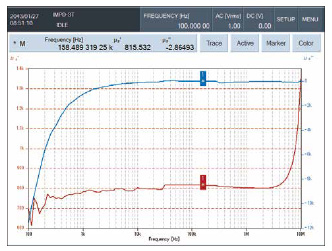
µs−Dµ
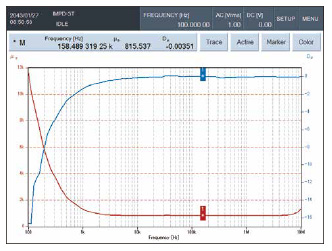
COMPARATOR/HANDLER INTERFACE Ideal for production lines!
Measurement up to 0.5 ms/point to shorten
takt time
Also with parts selection function!!
The comparator is a function that allows samples to be sorted or passed/rejected by setting the criteria range in advance based on measurement results.
Comparator setting screen
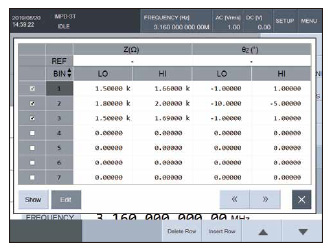
Bin sorting
Sorts results in up to 14 categories.
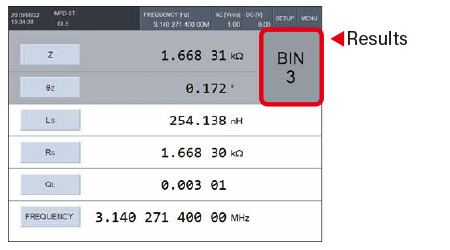
Limit sorting
Determines pass/reject based on the set range.
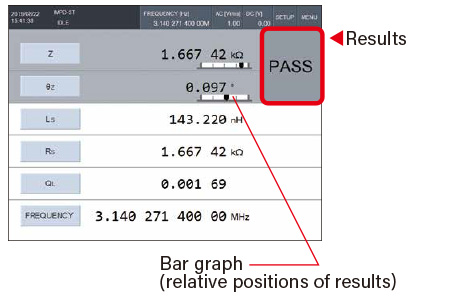
Zone sorting
Determines pass/reject based on sweep measurement results in two-dimensions, X axis (sweep parameter) and Y1, Y2 axes (measurement results).
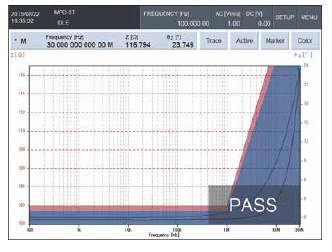
Handler interface
The comparator criteria results can be output to the handler interface connector. Connect a parts handler to create an automated parts sorting system.

EXTERNAL REFERENCE CLOCK
An external 10 MHz clock signal can be used as
the reference clock.
Using a reference clock with a higher precision than the internal reference clock helps to
improve the measurement frequency accuracy and stability.
The use of a reference clock
common with other devices also allows for the same frequency accuracy.
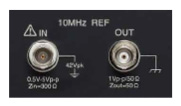
Mounted on rear panel
MEMORY CONTROL
Measurement conditions and measurement data can be saved and loaded onto the internal memory or USB memory storage.
● Electrochemical impedance characteristics measurements
Functions cover a range of measurements of electrochemical impedance characteristics, such as battery internal impedance measurements.
- ● Ultra-low frequencies from 10 µHz
- ● Phase slope compensation
function to limit measurements being affected
by potential changes due to charging and discharging - ● 0° SYNC function changes
the measurement frequency by 0° phase,
for zero charge transfer before and after measurements.
